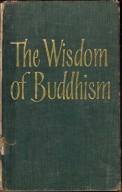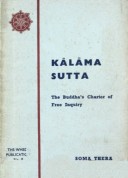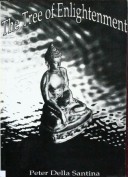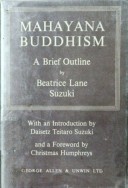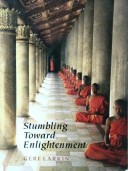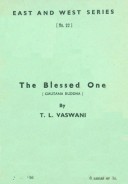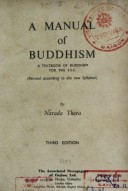Tìm Sách
Sách tiếng Anh-English >> The Wisdom Of Buddhism
Thông tin tra cứu
- Tên sách : The Wisdom Of Buddhism
- Tác giả : Christmas Humphreys
- Dịch giả :
- Ngôn ngữ : Anh
- Số trang : 280
- Nhà xuất bản : Michael Joseph London
- Năm xuất bản : 1960
- Phân loại : Sách tiếng Anh-English
- MCB : 12010000002954
- OPAC :
- Tóm tắt :
The Wisdom Of Buddhism
Edited by
CHRISTMAS HUMPHREYS
London
Michael Joseph
PREFACE
There is no such thing as a Buddhist ‘Bible’, in the sense of an authoritative statement of the teachings of Buddhism, and this for two seasons. First, because the Buddhist recognize no authority, human or divine, for what is truth, or seven for what Gautama the Buddha taught mankind, and secondly, because the range of country, language and time involved in the term Buddhism makes such a volume impossible to compile.
Buddhism, in the sense of the field of thought which has grown up about the Buddha’s name, was born in North India in the sixth century B.C, but within a thousand years or so it was established outside the land of its birth in at least ten countries, each with a defend language, and for fifteen hundred years the volume of Scriptures has been growing steadily. These scriptures range from the value of Sutras, meaning Sermons, alleged to be given by the Buddha, to minor Commentaries admittedly written a thousand years after the life of the Master. Yet few would claim that any sutra (in Pali: Sutta) is in fact in the Buddha’s own words, whereas many of the Commentaries, and the original sermons of later writers, are regarded as only second in value to the Teacher’s words. In its long history Buddhism has produced a number of the greatest minds, and the Scriptures are not closed. Such men are still with us, and in the absence of any better scripture quotation for the very deep teaching of the Kegon School of Japanese Buddhism I have not hesitated, for example, to include an extract from an Address to the Emperor of Japan by Dr. D. T. Suzuki which was later published as the Essence of Buddhism (see No.106)..
The Buddhist Scriptures, then, are a vast collection of writing in a dozen languages having this in common, that they stem from the Buddha’s Enlightenment as expressed through the medium of his own or lesser minds, and that they have the same basis of Teaching which is herein given as the Four Noble Truths (See No. 19). The rest is the Middle way, a way to be trodden by each and every Buddhist as he works out his own salvation with diligence to the same supreme Enlightenment.
CONTENTS
PREFACE
ACKNOWLEDGEMENTS
CHAPTER ONE THE BUDDHA
1 The Unborn
2 The Cosmic Buddha
3 His Three Bodies
4-6 The Truth-finder as a Way-Shower
7 The Buddha’s Pity
8-10 The Buddha within
CHAPTER TWO THE OLD WISDOM SCHOOLS
The Teaching of the Elders
11 Go ye forth, O Bhikkhus !
12 The Buddha’s Teaching
13 The First Sermon
14 The Fire Sermon
15 From the Dhammapada
What was not Taught
16 From the Potthapada Sutta
17 Vacchagotta, the Wanderer, is answered
18 The simpsapa Leaves
19 The Word of the Buddha concerning the Noble Truths and the Eightfold Path
20 The Four Noble Truths
21 The Four Stages and the Ten Fetters
No Authority
22 The Buddha’s Address to the Kalamas
23 The Test of True Teaching
Causality , Karma and Rebirth
24-30 Causality
31 the Doctrine of Rebirth
32 What is reborn
The sesf and the Not-self
33 The doctrine of No-Self
34 The Self is empty
35 The person as a Chariot
36 When the Fire goes out
37 Self die with Ignorance
Three Parables
38 The Blind men and the Elephant
39 Kisagotami and the Mustard Seed
40 The Parable of the Raft
The Buddhist Life
41 The purpose of the Buddhist Life
42 Good Works
43 Good Moral Habits
44 In this Six-foot Body
45 Getting Rid
46 The Greatest Blessing
47 Progress is Gradual
48,49 The Four sublime States of Mind
50 Boundless Goodwill
51,51 Fellowship with Beauty
53,55 The Arhat ideal
56 The Buddha’s Last Words
CHAPTER THREE TWO FURTHER SUTRAS OF THE OLD WISDOM SCHOOLS
57 From the Sutra of 42 Sections
58 From the Light of Asia
The New Wisdom Schools
CHAPTER FOUR THE NEW WISDOM SCHOOLS: INDIA
FROM THE SCRIPTURES
59 What is the Maha-yana?
From the perfection of Wisdom
60 Duality and Non-Duality
61 The Heart Sutra
62 From the Diamond Sutra
From the Lotus Sutra
63 The Buddha and the Rain-Cloud
64 Provisional and Final Nirvana
65 From the Exposition of Vinalakirti
66 The One Principle of Life
From the Lankavatara Sutra
67 Neither permanence nor Impermanence
68 No World outside the Mind
69 The Twop-fold Egolessness
70 From the Treatise in Twenty Stanzas by Vasubandhu
From the Awakening of Faith in the Mahayana
71 The Practice of Faith
From the Surangama Sutra
72 The Eye, the Mind and the Essence of Mind
73 The Control of Sexual Desire
From the Path of Light
74 The Master of the Banquet
75 Self-Surrender
76 Remembrance
77 Anger Unpremeditated
78 Regard for Others
79 The Perfect knowledge
SOME MAHAYANA THEMES
The Void
80 In Praise of the Void
81 Defilements stopped by Emptiness
82 The Buddha-nature and the Void
Suchness
83 Suchness
84 The Suchness of Form
85 The Truly so
86 The Zen unconscious, Suchness and the Middle Way
87 The Store Consciousness
Boddhisattva Ideal
88 The Boddhisattva’s Vow
89-92 The Boddhisattva’s Nature
93,94 The Boddhisattva’s Training
95,96 The Boddhisattva’s Compassion
97 The Boddhisattva’s Transfer of Merit
98 he does not seek Deliverance
99-100The Boddhisattva’s skilful Means
The Six Perfections
101 The Six Perfections
102,103 The Perfection of Giving
CHAPTER FIVE THE NEW WISDOM SCHOOLS: CHINA AND JAPAN
The Tendai School
104 On the Practice of meditation for Beginners
The Kegon School
105 True Enlightenment
106 Jijimuge
The Pure Land School
107 Concerning Faith
108 Honen on Salvation
109 The Pure Land
110 Mind-only
Records of Zen Masters
111 On Trust in the Heart
112 From the Platform Sutra of Hui-neng
The Zen teaching of Huang Po
113 I.From the Chiin Chou record
114 II. From the Wan Ling Record
115 Gradual and Sudden awakening
116 From the Shokoda of Yoka Daishi
117 From the Path to Sudden Attainment of Hui Hai
118 From the Blue Cliff Record (Hekigan Roku)
119 From the Gateless Gate (Mumon Kwan)
120 Dai-O Kokushi ‘On zen’
CHAPTER SIX THE BUDDHISM OF TIBET
121 Milarepa and the Novices
122 From the Precepts of the Gurus
123 From the Song of Saraha
124 From the Buddha’s Law among the Birds
125 From the Voice of the Silence
CHAPTER SEVEN CONCENTRATION AND MEDITATION
126 The Advantages of Meditation
127 The purpose of meditation
128 How to Begin
129 The Use of Breathing
130 Virtue and Meditation
131 The perfection of meditation
132 The Four Methods of Mindfulness
The Fruits of Meditation
133 inward Peace
134 transparent Luminosity of Mind
135 The Essence of Mind
136 Beyond Thought
137 Hakuin’s Song of Meditation
CHAPTER EIGHT THE BUDDHIST ORDER
The Ideal Monk
138 the Buddha’s Advice to Sariputra
139 No Falling Back
140 Dai-O Kokushi’s Admonition to his Disciples
The Monk’s Life
141 Mindful and Self-possessed
142 Tending the Sick
143 Meeting together
144 The rules of the Order
145 The Ten Precepts
CHAPTER NINE NIRVANA
Nos. 146-151
SOURCES
ABREVATIONS USED IN LIST OF SOURCES
GLOSSARY
INDEX
 Facebook
Facebook
 Google
Google
 Google+
Google+
